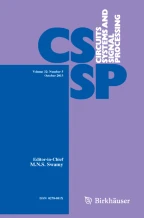Abstract
Aiming to accelerate convergence speed and reduce steady-state misalignment of adaptive filter, a new data-reusing algorithm is proposed. Different from conventional affine projection algorithm (APA) based on minimum disturbance principle (MDP), the proposed algorithm obtains its cost function based on a convex combination of the minimum norm principle (MNP) and the MDP. Weight factor (named as mixing parameter) used in the combination determines the approach for updating. The proposed algorithm has a performance similar to the APA when the mixing parameter closes to 0 and yields results to the data-reusing algorithm based on the MNP if the mixing parameter closes to 1. By minimizing mean-square deviation, the variable mixing parameter has a large value at initial stage and gradually decreases as iteration number increases. At the initial stage, the proposed algorithm achieves fast convergence since the MNP plays a leading role. At the steady-state, the proposed algorithm obtains a low misalignment since the MDP gives a major impact and the updated results have minimum disturbance from the previous ones. At the transition stage, the proposed algorithm is a combination of the APA and the MNP-based data-reusing algorithm. Simulation results show that the proposed algorithm exhibits faster convergence rate and lower steady-state misalignment than some other derivatives of the APA without significantly increasing computational complexity.
Similar content being viewed by others
References
T. Aboulnasr, K. Mayyas, A robust variable step-size LMS-type algorithm: analysis and simulations. IEEE Trans. Signal Process. 45(3), 631–639 (1997). doi:10.1109/78.558478
J.H. Choi, S.H. Kim, W.K. Sang, Adaptive combination of affine projection and NLMS algorithms. Signal Process. 100(7), 64–70 (2014). doi:10.1016/j.sigpro.2014.01.015
S.C. Douglas, A family of normalized LMS algorithms. Signal Process. Lett. 1(3), 49–51 (1994). doi:10.1109/97.295321
S.E. Kim, S.J. Kong, W.J. Song, An affine projection algorithm with evolving order. IEEE Signal Process. Lett. 16(11), 937–940 (2009). doi:10.1109/LSP.2009.2027638
K. Ozeki, T. Umeda, An adaptive filtering algorithm using an orthogonal projection to an affine subspace and its properties. Electron. Commun. Jpn. 67(5), 19–27 (1984). doi:10.1002/ecja.4400670503
P. Park, M. Jang, N. Kong, Scheduled-stepsize NLMS algorithm. IEEE Signal Process. Lett. 16(12), 1055–1058 (2009). doi:10.1109/LSP.2009.2026197
P. Park, C.H. Lee, J.W. Ko, Mean-square deviation analysis of affine projection algorithm. IEEE Trans. Signal Process. 59(12), 5789–5799 (2011). doi:10.1109/TSP.2011.2165709
T. Paul, T. Ogunfunmi, On the convergence behavior of the affine projection algorithm for adaptive filters. IEEE Trans. Circuits Syst. I 58(8), 1813–1826 (2011). doi:10.1109/TCSI.2011.2106091
D.T.M. Slock, On the convergence behavior of the LMS and the normalized LMS algorithms. IEEE Trans. Signal Process. 41(9), 2811–2825 (1993). doi:10.1109/78.236504
S.G. Sankaran, A.A.L. Beex, Tracking analysis results for NLMS and APA. in Proc. ICASSP-02, Orlando, USA, vol. 2, pp. 1105–1108 (2002). doi:10.1109/ICASSP.2002.5743992
S.G. Sankaran, A.A.L. Beex, Convergence behavior of affine projection algorithms. IEEE Trans. Signal Process. 48(4), 1086–1096 (2000). doi:10.1109/78.827542
H.C. Shin, A.H. Sayed, Mean-square performance of a family of affine projection algorithms. IEEE Trans. Signal Process. 52(1), 90–102 (2004). doi:10.1109/TSP.2003.820077
H.-C. Shin, A.H. Sayed, W.-J. Song, Variable step-size NLMS and affine projection algorithms. IEEE Signal Process. Lett. 11(2), 132–135 (2004). doi:10.1109/LSP.2003.821722
L.R. Vega, H. Rey, J. Benesty, S. Tressens, A new robust variable step-size NLMS algorithm. IEEE Trans. Signal Process. 56(5), 1878–1893 (2008). doi:10.1109/TSP.2007.913142
J. Wang, Z. Lu, Y. Li, A. New, CDMA Encoding/Decoding Method for on-Chip Communication Network. IEEE Trans. VLSI Syst. 24(4), 1607–1611 (2015). doi:10.1109/TVLSI.2015.2471077
B. Widrow, S.D. Sterns, Adaptive Signal Processing (Prentice-Hall, Englewood Cliffs, 1985), pp. 33–186
Author information
Authors and Affiliations
Corresponding author
Rights and permissions
About this article
Cite this article
Ren, C., Wang, Z. & Zhao, Z. A New Data-Reusing Algorithm Based on Minimum Norm and Minimum Disturbance Principles. Circuits Syst Signal Process 36, 1948–1969 (2017). https://doi.org/10.1007/s00034-016-0387-3
Received:
Revised:
Accepted:
Published:
Issue Date:
DOI: https://doi.org/10.1007/s00034-016-0387-3
